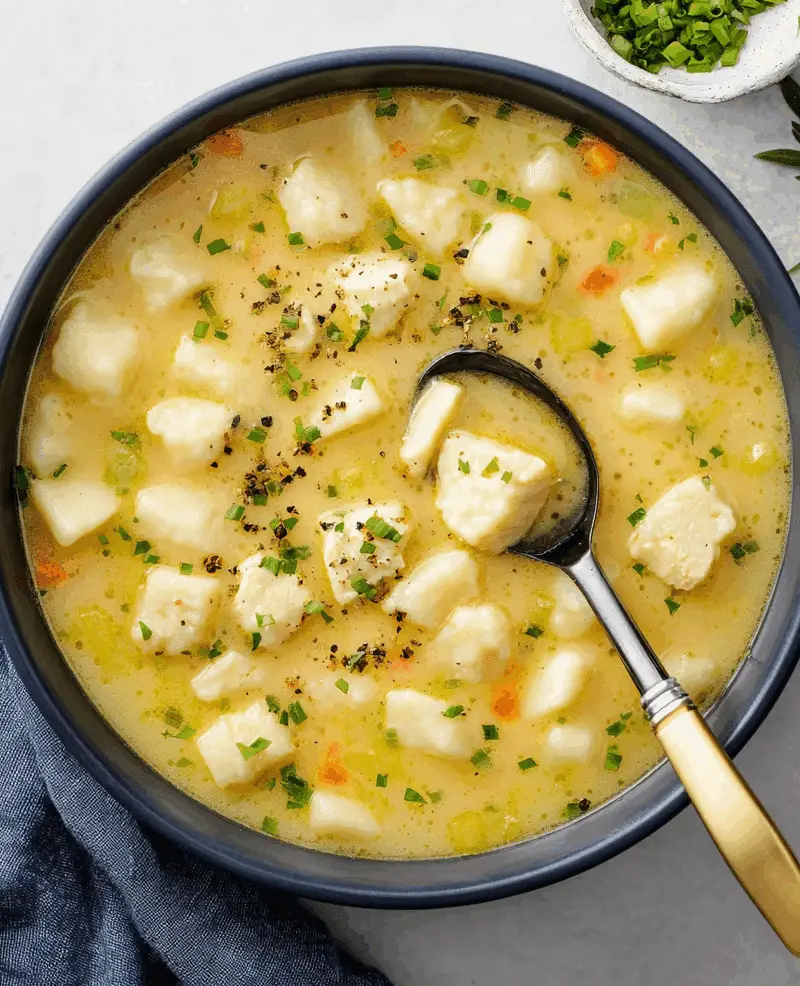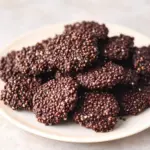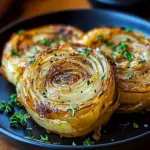The heartwarming tradition of German-American cuisine comes to life with this delicious bowl of Knoephla Soup. Rooted in Midwest heritage and brimming with nostalgia, this creamy potato dumpling soup is the kind of dish that warms both body and soul. It’s a perfect tribute to the homestyle meals passed down through generations.
The pillowy dumplings (or “knoephla”) are soft and satisfying, while the broth is enriched with butter, cream, and tender potatoes. Ideal for chilly evenings, family gatherings, or simply when you crave comfort in every spoonful, this soup brings simplicity and richness together in one unforgettable dish.
Full Recipe
Ingredients:
-
6 tablespoons butter, divided
-
1 small onion, diced
-
2 celery stalks, diced
-
2 large russet potatoes, peeled and cubed
-
6 cups chicken broth
-
2 cups half-and-half
-
2 teaspoons salt
-
1/2 teaspoon black pepper
-
2 cups all-purpose flour
-
1 egg
-
1/2 cup water
Directions:
-
In a large pot, melt 3 tablespoons of butter over medium heat. Add diced onion and celery, sautéing until soft and translucent, about 5 minutes.
-
Stir in potatoes, broth, salt, and pepper. Bring to a boil, then reduce heat and simmer for 15 minutes or until potatoes are tender.
-
While the soup simmers, prepare the dumplings. In a medium bowl, combine flour, egg, and water to form a soft dough. Add a pinch of salt if desired.
-
Drop small spoonfuls of dough into the simmering soup. Simmer for an additional 10 minutes, or until dumplings are cooked through and float to the top.
-
Add remaining 3 tablespoons of butter and pour in the half-and-half. Stir gently and cook another 5 minutes on low heat until creamy and warm.
-
Adjust seasoning if needed, and serve hot with a sprinkle of fresh herbs or cracked pepper.
Prep Time: 15 minutes | Cooking Time: 30 minutes | Total Time: 45 minutes
Kcal: 320 kcal | Servings: 6 servings
A Comforting Legacy: The History of Knoephla Soup
Knoephla Soup is more than just a bowl of creamy comfort—it’s a rich culinary tradition rooted in the German-Russian communities that settled across the American Midwest, particularly North Dakota. These immigrants brought with them a repertoire of humble, hearty dishes designed to nourish during long, cold winters. The word “knoephla” is believed to derive from the German word “Knöpfle,” which refers to small dumplings. These pillowy morsels, made simply from flour, egg, and water, were affordable and filling—perfect for families relying on pantry staples. Over time, the dish evolved into a thick, creamy soup made with potatoes, butter, and sometimes chicken, but it always retained its signature dumplings.
Why Knoephla Soup is the Ultimate Comfort Food
What sets Knoephla Soup apart from other creamy soups is its texture and depth of flavor. The combination of tender potatoes and rich, buttery broth creates a velvety base that clings to each dumpling, turning every bite into pure comfort. The dumplings add a chewy contrast and help thicken the soup naturally, making it heartier and more satisfying. While many comfort foods may rely on cream or cheese, Knoephla’s richness comes from a balance of butter and half-and-half, which enhances flavor without overwhelming it. It’s a meal that feels like a warm hug—simple yet deeply nourishing.
Cultural Roots and Midwestern Heritage
Knoephla Soup carries a story of resilience and adaptability. For German-Russian immigrants, recreating their traditional dishes in a new land meant using whatever ingredients were available. The result was a uniquely Americanized version of German dumpling soup, adapted to local tastes and regional ingredients. In North Dakota, it has become a symbol of culinary heritage, often served at church suppers, community potlucks, and family gatherings. The dish reflects the resourcefulness and heart of a community that values togetherness, warmth, and simplicity.
The Role of Dumplings in European Cuisine
Dumplings have a long and varied history across Europe. From Italian gnocchi to Hungarian nokedli, nearly every culture has its own version of flour-based dough dropped into boiling liquid. Knoephla dumplings are close relatives to spaetzle or knöpfle, traditionally pan-fried or added to stews. In soup, they take on a soft, chewy quality that perfectly complements hearty broths. While some dumplings are leavened or filled, knoephla are deliberately simple, focusing on texture and their ability to absorb the flavors of the soup. Their minimalism is their strength.
Modern Twists and Variations
Though traditional Knoephla Soup is made with just potatoes and dumplings, modern versions often introduce ingredients like carrots, celery, shredded chicken, or leeks for added complexity. Some cooks add a splash of white wine or vinegar to brighten the flavor, while others use chicken stock instead of plain water for more richness. Vegetarians can easily adapt the recipe by using vegetable broth and plant-based milk alternatives. Those who enjoy spice can add black pepper or paprika, while fresh herbs like dill or parsley offer a fragrant finish. It’s a versatile canvas, ready to be customized.
Texture and Taste: What to Expect in Every Spoonful
The hallmark of Knoephla Soup is its creamy, slightly thickened texture and the way it coats the mouth with buttery goodness. Each bite should include a tender potato cube, a soft dumpling, and a smooth spoonful of broth. The flavor profile is mellow but satisfying—rich without being overwhelming. There’s a pleasant chew to the dumplings that plays well with the softness of the vegetables. A good Knoephla Soup doesn’t need a long list of ingredients; it relies on balance, time, and care to create a wholesome flavor experience.
Serving Suggestions and Pairings
Knoephla Soup is traditionally served as a main dish, accompanied by nothing more than a slice of rustic bread or a buttered dinner roll. If you’re looking to round out the meal, consider a simple green salad with vinaigrette or roasted root vegetables on the side. For drink pairings, a crisp Riesling or a malty German-style beer works well, cutting through the richness while enhancing the soup’s earthy tones. Leftovers are excellent the next day, as the flavors deepen and the dumplings absorb even more of the broth.
Tips for the Perfect Knoephla Soup
To achieve the best results, it’s important to give the dumplings time to simmer gently—too vigorous a boil will break them apart. Be sure not to overwork the dough, which can make dumplings tough instead of tender. When making the broth, allow the butter to infuse the vegetables before adding liquids, which brings out the natural sweetness of the onion and celery. Use starchy russet potatoes, which break down slightly and help thicken the soup. For a silkier texture, you can mash a few potatoes directly in the pot once they’re soft. Taste and adjust seasoning at the end—sometimes a final touch of salt, pepper, or fresh parsley makes all the difference.
Health Benefits and Nutritional Notes
Though Knoephla Soup is rich and hearty, it also provides a good balance of carbohydrates and fats that can be part of a satisfying meal. Potatoes offer fiber and potassium, while the dumplings add a source of energy from complex carbs. Using half-and-half instead of heavy cream reduces fat content without sacrificing creaminess. Homemade versions also allow for control over salt, making it a healthier choice than canned or restaurant options. For a lighter version, consider using whole wheat flour for the dumplings or incorporating more vegetables for added nutrients.
Storing and Reheating Leftovers
Knoephla Soup stores beautifully and actually improves in flavor over time. It can be refrigerated for up to 4 days in an airtight container. The dumplings will continue to absorb liquid, so you may need to add a splash of broth or milk when reheating. For best results, reheat on the stovetop over low heat, stirring frequently to prevent scorching. While the soup can be frozen, be aware that the texture of the dumplings may change slightly upon thawing. If freezing, consider making and storing the dumplings separately from the broth.
Why Knoephla Soup Deserves a Spot in Your Recipe Collection
Whether you grew up eating Knoephla Soup or are discovering it for the first time, this dish embodies everything we love about comfort food: it’s warm, filling, simple, and made with love. It’s the kind of meal that evokes memories, or helps create new ones. From its European roots to its cherished place in American home kitchens, Knoephla Soup tells a story in every bowl. It’s also a forgiving recipe, open to tweaks and variations, which makes it ideal for both beginner cooks and seasoned chefs alike. It may not look fancy, but its soul-satisfying taste leaves a lasting impression.
Conclusion
Knoephla Soup is a timeless dish that bridges cultures, generations, and kitchens with its humble ingredients and powerful comfort. Its thick, creamy texture and soft dumplings create a satisfying, soul-warming experience that appeals to all ages. Whether enjoyed on a cold winter night or served as a nostalgic centerpiece for family dinner, it’s a soup that delivers both nourishment and joy. Add it to your recipe rotation and you’ll find yourself returning to it again and again—not just for its flavor, but for the feeling it brings with every spoonful.








